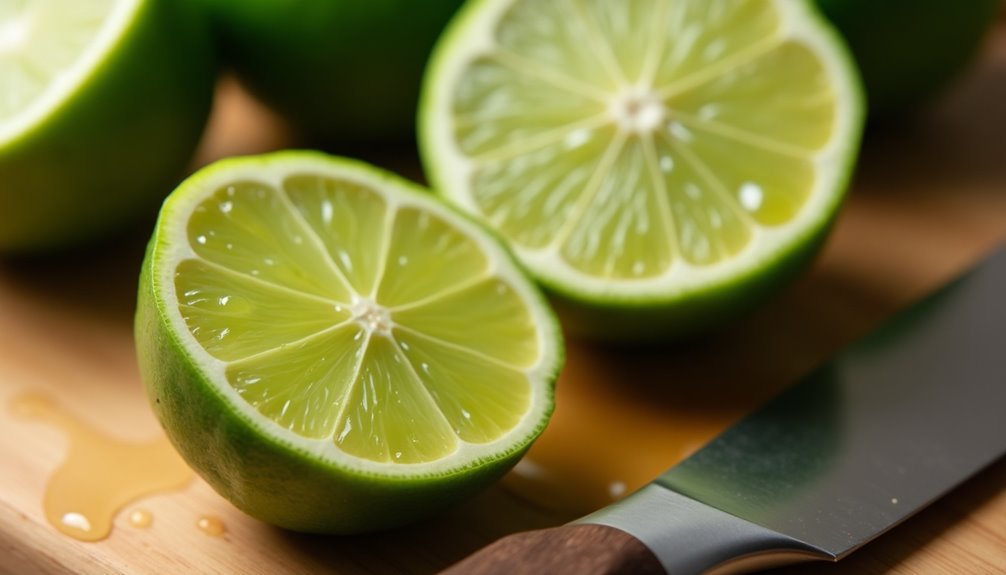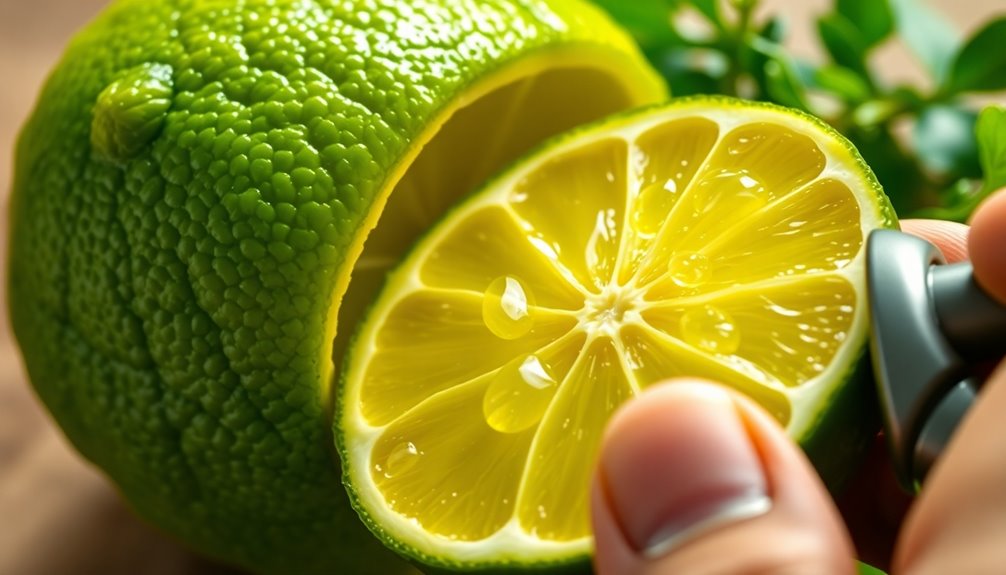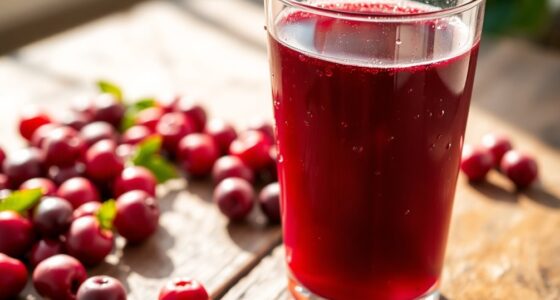To get the most juice out of a lime, start by microwaving it for 20 to 30 seconds to burst the juice capsules. Then, roll it on the countertop while applying pressure. Slice the lime lengthwise for a better grip and squeeze it using your fingers first, followed by a sharp reamer or juicer for maximum extraction. Store unused limes in a plastic bag in the fridge to keep them juicy. You'll discover more effective techniques ahead!
Key Takeaways
- Microwave the lime for 20-30 seconds to increase juice yield by bursting juice capsules.
- Roll the lime on a countertop while applying pressure to break open juice capsules effectively.
- Cut the lime lengthwise for better grip and easier squeezing, maximizing juice output.
- Use good-quality tools like a sharp reamer or juicer to enhance juice extraction.
- Store limes in a plastic bag in the refrigerator to maintain moisture and prevent drying out.

Getting the most juice out of a lime can make a big difference in your recipes, whether you're mixing up a cocktail or adding zest to a dish. You want every drop you can get, so let's explore some effective techniques to maximize your lime juice extraction. The right methods can't only enhance flavor but also elevate your culinary creations.
To start, try microwaving your lime for about 20 to 30 seconds on high. This simple step bursts the juice capsules inside the fruit, making extraction easier and significantly increasing the yield. You might be surprised at how much more juice you can get just by warming it up a little.
Once you've microwaved the lime, roll it gently on the countertop while applying some pressure. This technique helps break open those juice capsules further, ensuring you get every last drop when it's time to squeeze.
When it comes time to cut your lime, consider slicing it lengthwise instead of crosswise. This method improves your grip and makes it easier to apply force while squeezing, which can help maximize juice output.
After cutting, you can use your fingers to squeeze, but if you want to take it up a notch, it's time to grab a tool. Using a sharp reamer or juicer can drastically improve your juice extraction. Dull tools can lead to less juice being released, so investing in a good-quality reamer is worth it. You'll find that the sharper the tool, the more efficiently it works to extract juice from the lime.
Storage also plays a crucial role in getting the most juice. If you've got limes sitting around, keep them in a plastic bag in the crisper of your refrigerator. This helps maintain their moisture, preventing the rinds from becoming hard and ensuring a higher juice yield when you finally juice them. Dried-out limes won't give you as much juice, so proper storage is essential.
After following these steps, you'll be ready to juice your limes. Squeeze over your favorite cocktail, drizzle it on a salad, or incorporate it into a marinade. The techniques you've learned will make a noticeable difference in how much juice you extract, bringing an enhanced flavor profile to whatever you're preparing.
Frequently Asked Questions
What Is the Best Way to Get the Most Juice Out of a Lime?
To get the most juice out of a lime, try microwaving it for 20 to 30 seconds. This heats the fruit and helps burst juice capsules.
Then, roll the lime on a countertop while applying gentle pressure to further loosen the juice. Cut it lengthwise for better grip and squeeze efficiency.
If you're facing a particularly dry lime, poke the flesh with a fork to access trapped juice before juicing.
How Do You Cut a Lime for Maximum Juice?
You'd think cutting a lime is simple, right? Well, if you want to maximize juice, there's a bit more to it.
Start by cutting the lime lengthwise; this exposes more juice-filled segments. Use a sharp knife for clean cuts and ensure the lime's at room temperature for easier squeezing.
Consider quartering it after halving for better handling. These techniques will help you extract every last drop of that zesty goodness!
How to Make Lime Super Juice?
To make lime super juice, start by microwaving the lime for 20 to 30 seconds. This helps burst the juice capsules inside.
Then, roll it on a countertop while applying gentle pressure. Cut the lime in half and use a sharp reamer or juicer to extract the juice effectively.
If the lime feels dry, poke it with a fork to release any trapped juice. Enjoy your concentrated, flavorful lime juice!
How to Get the Maximum Juice From Lemon?
Did you know that a single lemon can yield about 3 tablespoons of juice?
To maximize that yield, start by microwaving your lemon for 20 to 30 seconds. Then, roll it on a countertop while applying gentle pressure. Cut it lengthwise for better grip and use a sharp juicer to extract every drop.
Finally, store unused lemons in a plastic bag in the crisper drawer to keep them fresh for your next juicing session.
Conclusion
To really maximize the juice from your lime, remember to roll it firmly on a countertop before cutting. Imagine you're prepping for taco night with friends; you gently roll a few limes, cut them in half, and easily extract every drop of tangy goodness. By using this simple technique, you've got enough lime juice for a zesty marinade and refreshing drinks, ensuring your meal is bursting with flavor. Enjoy your culinary success and impress your guests!
Cindy thoroughly researches juicing trends, techniques, and recipes to provide readers with practical advice and inspiration. Her writing style is accessible, engaging, and designed to make complex concepts easy to understand. Cindy’s dedication to promoting the advantages of juicing shines through her work, empowering readers to make positive changes in their lives through the simple act of juicing.











